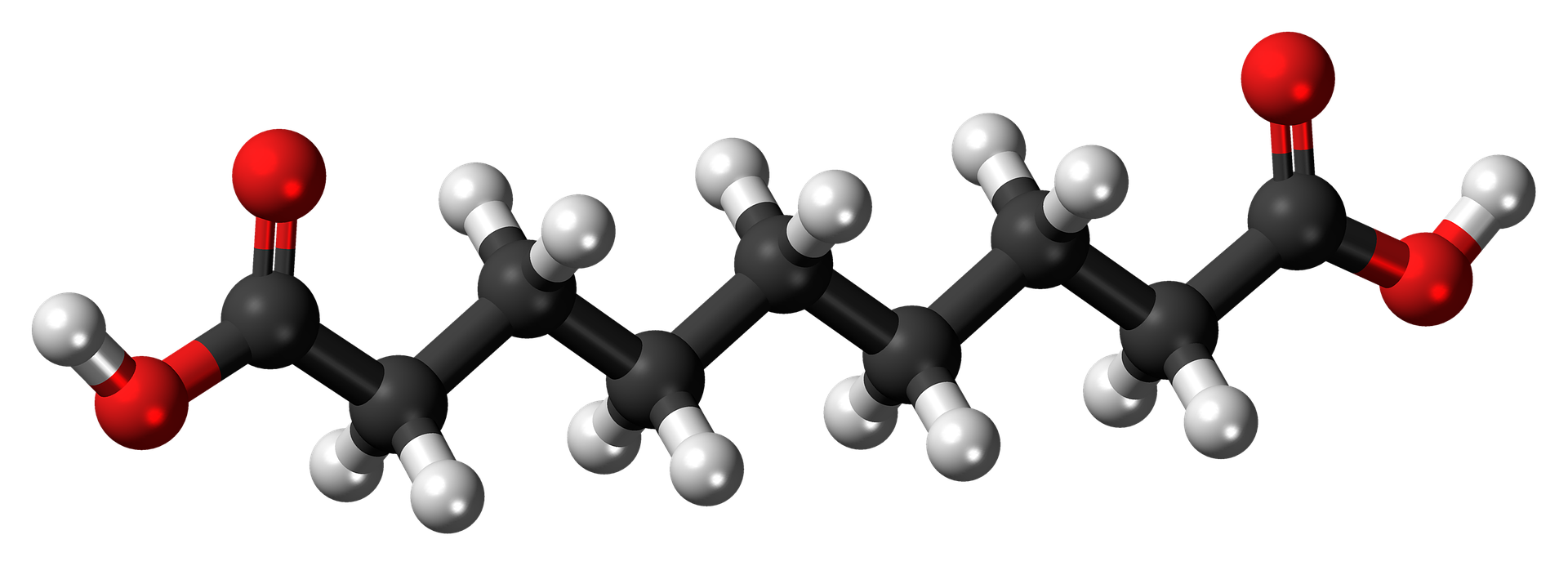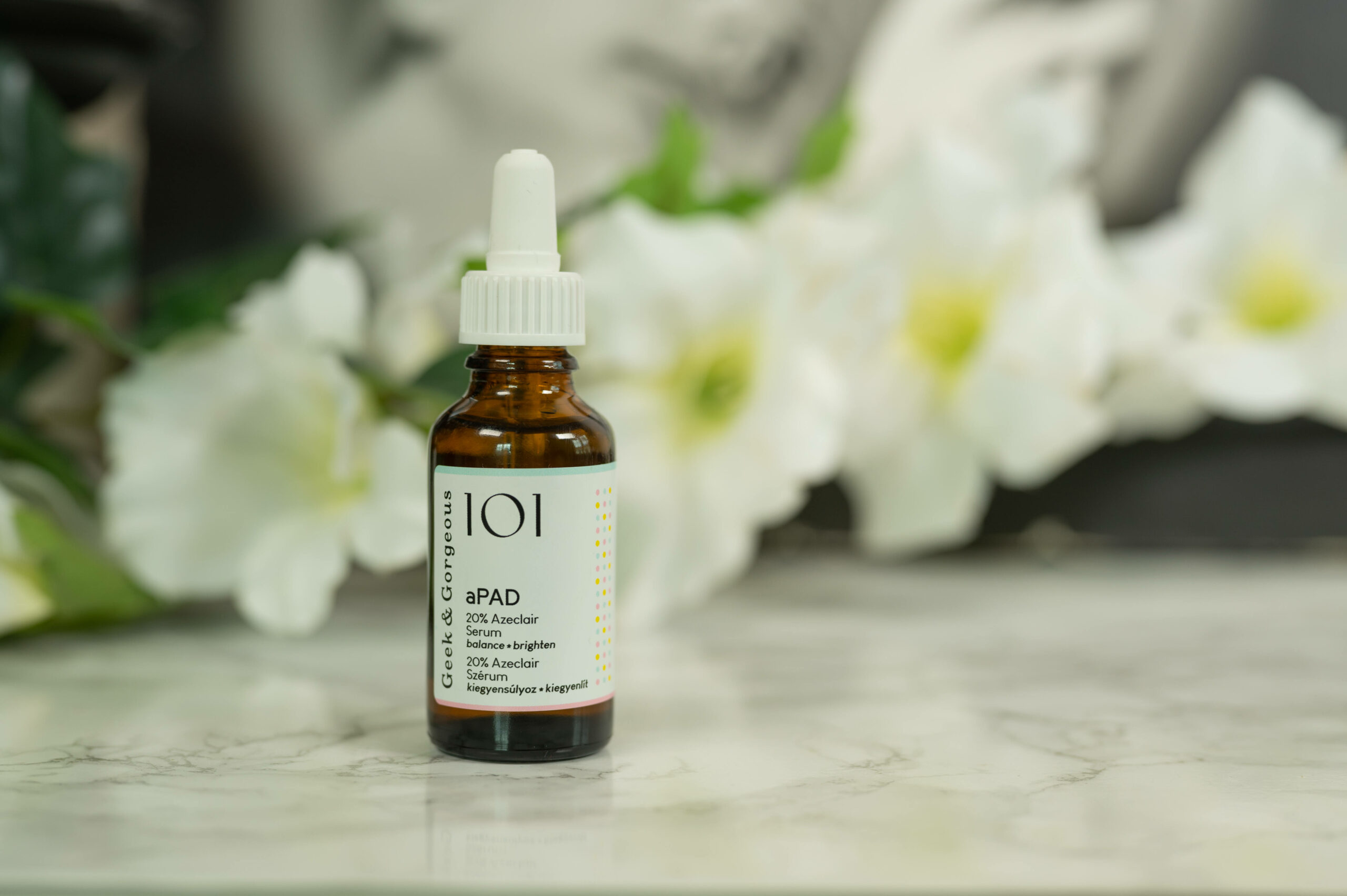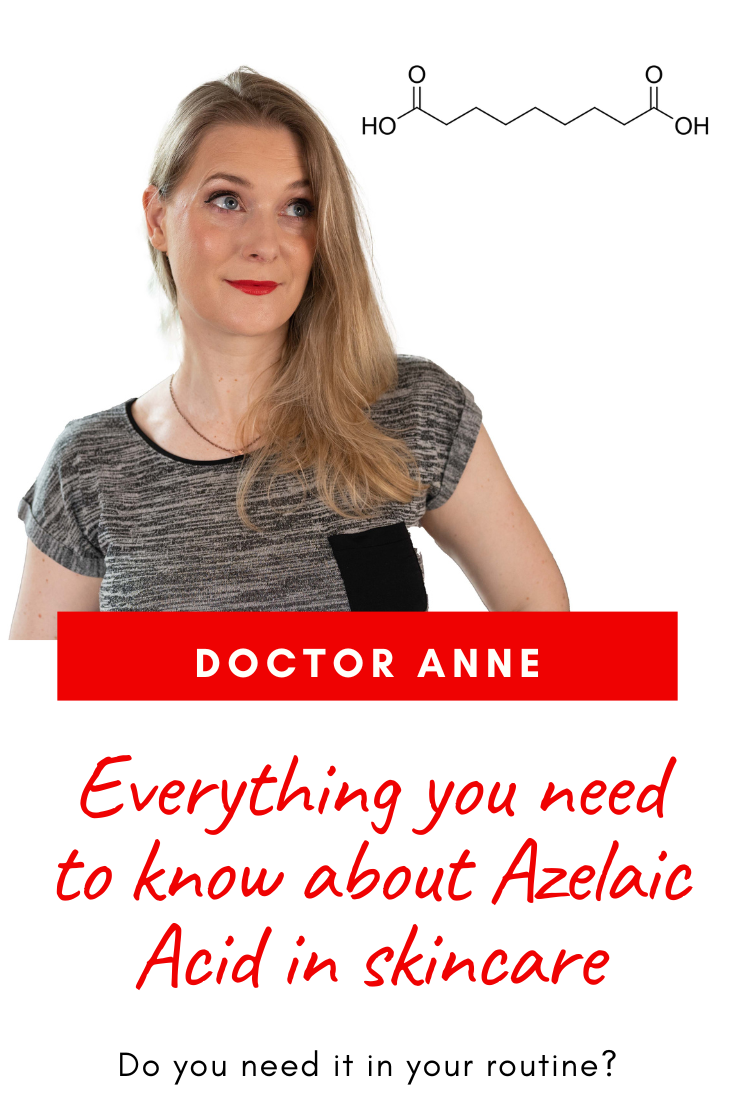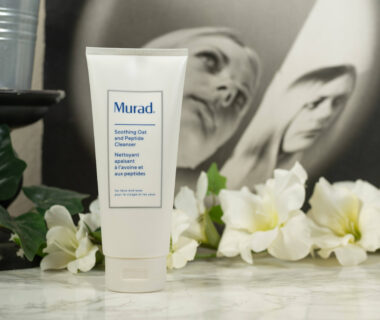ADVERTISEMENT INFO: PRODUCTS MENTIONED AT THE END OF THIS POST ARE PR (GIFTED) AND LINKS USED ARE AFFILIATE LINKS. I RECEIVED NO MONEY TO WRITE THE BLOGPOST. PLEASE READ DISCLAIMER
I did a blogpost on the Do’s and Don’ts for rosacea skincare a while ago, and in this video I mentioned Azelaic Acid and its benefits for the skin. (More info: The best skincare tips for rosacea skin)

Now Azelaic Acid is not only for those of us suffering from rosacea, but can be helpful in acne, melasma and postinflammatory hyperpigmentation as well, so I figured it was about time we took a closer look at the ingredient to see who exactly will benefit from introducing it in their skincare routine, which other actives it is best paired with and what to look for when buying products.
What is Azelaic Acid?
Azelaic Acid is an acid naturally occurring on our skin where it is produced by Malassezia furfur, one of the yeasts that inhabit our face, and that is also found in wheat, rye and barley. (More info: What is the skin microbiome?)
The formula is HOOC(CH2)7COOH, and it usually presents itself as white powder that isn’t the easiest to dissolve, which is why products with higher concentrations (meaning above 15%) often have a grainy texture.

How does Azelaic Acid work?
Azelaic Acid has different mechanisms of action that are potentially beneficial for the skin. It is antiinflammatory, it is antimicrobial, it inhibits follicular keratinization and it acts as Tyrosinase inhibitor, meaning it reduces the amount of melanin melanocytes produce, alongside an additional effect on mitochondrial DNA of those melanocytes.
Unlike other Tyrosinase inhibitors though, Azelaic Acid has an affinity for abnormal melanocytes as in the ones that are hyperactive, so it is well suited for skin of color struggling with hyperpigmentation. (More info: The different types of hyperpigmentation)
These effects on the skin have been mainly demonstrated using a cream with 20% Azelaic Acid, which is usually reserved for prescription products, applied twice a day. While it isn’t far off to assume that a lower concentration will give you similar results with consistent use over a prolonged period of time, it is also not guaranteed that you will.
Which skin issues is Azelaic Acid best for?
The trias of it being antiinflammatory, antimicrobial and normalizing keratinization makes Azelaic Acid a good choice for people struggling with acne, especially if their acne tends to leave pigmentation behind. The normalized keratinization means pores don’t get clogged as easily, it helps reduce bacteria responsible for acne like Cutibacterium acnei and it reduces both the inflammation in spots that are already formed as well as the risk of melanocytes going into overdrive as reaction to this inflammation.
The antiinflammatory effect is also why it is often used in Rosacea, where it can be used both preventative as well as in acute flare-ups. (More info: Building a skincare routine for rosacea skin)
The fact that it both has an affinity to abnormal aka hyperactive melanocytes and is safe to use in pregnancy and breastfeeding means it is a very good option for treating melasma as well as other hyperpigmentation issues in pregnant people or people of color. (More info: Which skincare is safe to use in pregnancy)
Which side effects do you need to be aware of when using Azelaic Acid?
As it is true for most ingredients, the risk for side effects correlates with the concentration used. While irritation is of course possible at concentrations as low as 5%, the risk increases once you reach the 15-20% that are usually found in prescription.
The most common side effects would be irritation and dryness, which is especially troublesome for those with rosacea and usually less of an issue for those with oily, acneic skin.
Much of the irritation potential seems to correlate with the vehicle used, with gel formulas being better tolerated than creams, so if you react strongly, changing the product might be something to look into. (More info: The 5 things to do when your skin barrier is damaged)
How do you introduce Azelaic Acid into your routine?
The best way to introduce Azelaic Acid into your routine absolutely depends on why you intend on using it. If you just want some in your routine because you feel every skin could benefit and you want some of the anti inflammatory, anti hyperpigmentation and anti congestion effects because you feel it could make your skin just that little bit better, then the best way is to start with a low concentration (5% is the lowest I have seen on the market, but usually 10% should be fine) and start by using it three days a week for a few weeks, then five days a week and finally every day or as often as you want to.
Keep it separate from your other actives like strong retinoids or other exfoliating acids should you use them – unless they are formulated together, in which case you should be fine. This will help you get no irritation, but will also require a lot of patience before you see any results.
If you are prescribed Azelaic Acid or for some reason have a skin issue you feel needs to be treated with Azelaic Acid alone, like Rosacea or melasma in pregnancy, you are most likely using 15-20% concentrations, as everything else will not get you the results you are looking for. Here the obvious advice is to talk to your prescribing doctor about your concerns and follow their advice, but the risk for irritation is high, as to get optimal results you will most likely be told to use the Azelaic Acid twice a day every day.
For some this will work with minimal irritation they can push through – it usually subsides after around six weeks when your skin gets accustomed to the ingredient – but if you feel it is more than you can take, use the tips I outlined on how to introduce Tretinoin with minimal irritation. (More info: How to introduce Retin-A with minimal irritation)
In short: Start with a few days a week once a day, slowly increase the frequency, keep the rest of your skincare as gentle and soothing as possible and, most importantly, have patience.
Once your skin is accustomed to it, you can pair Azelaic Acid with other actives to best reach your skin goals – obviously in moderation, you don’t want to anger your skin, but there is no need to worry about any interactions. The exception of the rule is as always rosacea, where your skin will react quicker and you should be extra careful. (More info: What is skinimalism and why is it good for you?)

Products with Azelaic Acid
Prescription aside, there are a few options on the market, most of which I haven’t tried myself. Despite all the benefits I have listed, Azelaic Acid isn’t an ingredient I feel the need to have in my routine.
The most affordable option is surely The Ordinary Azelaic Acid Suspension 10% (100 ml for 25,80 € or 30 ml for 10.80 €, available here), another well known one is the Paula’s Choice Boost 10% Azelaic Acid Booster Cream (30 ml for 39 €, available here). From what I have heard, Paula’s Choice has the more elegant texture, but is also triple the price and contains Salicylic Acid as an additional ingredient.
Other products that combine Azelaic Acid with other ingredients are from the Dr Sam Bunting line. Here I have tried the Dr Sam’s Flawless Neutralizing Gel (30 ml for 28 $, full review here) which combines 5% Azelaic Acid with 2% Salicylic Acid and 0,5% Bakuchiol. I like it as a spot treatment as it really brings down red and inflamed zits pretty quickly. The other one I have tried is the Dr Sam’s Flawless Nightly Serum (30 ml for 44 $, full review here), which combines the 5% Azelaic Acid with Niacinamide, Granactive Retinoid and again Bakuchiol. Due to their low Azelaic Acid concentration I would see them as all rounders more than as products to seek out if you want the specific Azelaic Acid effects. (More info: Niacinamide in skincare and Your comprehensive retinoid guide)
Lastly I want to draw your attention to products like the Geek and Gorgeous aPad 20% Azeclair Serum (30 ml for 10,50 €, vegan, full review here) that talk about the benefits of Azelaic Acid, but use a derivative called Potassium Azeloyl Diglycinate or PAD that is much nicer to formulate with. The aPad Serum contains 20% Azeclair, which as a solution contains 6% PAD, which again is roughly equivalent to 3% Azelaic Acid. There are studies done on PAD which show promising results at 1-3% concentration when used on rosacea skin or melasma, but you obviously can’t transfer the data we have on Azelaic Acid to these products.
As always, there is a wide and sometimes confusing variety of options…
Bottom line
Azelaic Acid has many benefits for different skin conditions, but you need to make sure your get the right concentration and the right vehicle for you. If you really have concerns that require Azelaic Acid to be used at the best effect, you need to talk to your doctor about prescription and prepare for a cosmetically less elegant routine.
If you want it for it’s additional benefits, but don’t want to risk side effects, I would suggest going with the 10% options using true Azelaic Acid and if you just think that it sounds nice to have, go for one of the mix options like the Dr Sam’s Serums – 5% isn’t going to get you major changes, but maybe an overall improvement.
As I am pretty happy with my Tretinoin/ Vitamin C/ Salicylic Acid rotation, I don’t use it personally, but think it is an interesting option to consider depending on your current skin issues.

Shop some products with Azelaic Acid here
Don’t forget to check out the Discount Code Page on top if you want to save some money on your next skincare purchase.
If you want to get a vote in the next Ask Doctor Anne Topic, Ingredient Spotlight or product I review, don’t forget you can head over to my Patreon account to get more involved!


